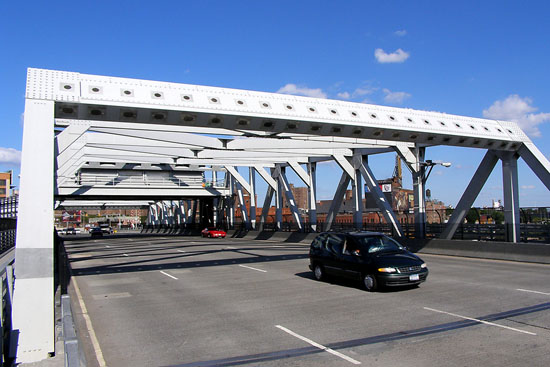Congestion Pricing vs. Ravitch Plan: Which is Better for the Boroughs?

Under the Ravitch Plan, driving into Manhattan over the Third Avenue Bridge will be a relative bargain for Richard Brodsky’s Westchester constituents.
It’s easy to dismiss City Councilmembers Lew Fidler and Peter Vallone, Jr. as transportation troglodytes. They’ve led the pushback against bridge tolls — most recently at the City Council hearing this week on the Ravitch Commission recommendations — yet neither has ever put forth a workable alternative for reducing job-killing, community-wrecking traffic congestion. Judging by their anti-toll rhetoric, you’d think that half their district drives to jobs in the Manhattan Central Business District, yet the actual percentages who do so are surprisingly meager: 5.3 percent for Fidler’s Brooklyn district and 4.4 percent for Vallone’s Queens district (plus another 1.7 percent and 1.3 percent, respectively, who carpool).
But in one respect, bridge-toll opponents may have a point: tolling equity. According to my calculations, 60 percent of the proposed Ravitch bridge tolls would be paid by Brooklyn and Queens residents. Yet these residents make only 36 percent of car trips into the CBD. The disparity would mean a hefty cross-subsidy — worth a few hundred million dollars a year — of the region’s drivers by drivers from these two boroughs.
Whence the disparity? There are two sources. First, the Ravitch plan imposes no new tolls on auto trips into the Manhattan core that come from New Jersey and northern Manhattan; these constitute almost one-quarter of the total. Second, another 20% of trips into the CBD — from Bronx, Westchester and other points north — use one of the Harlem River bridges. Ravitch wants those drivers to pay less than half the standard MTA toll rate that would apply to the four East River crossings — the Brooklyn, Manhattan, Williamsburg and Queensboro Bridges.
Under the Bloomberg congestion pricing plan, Brooklyn and Queens actually bore a fairer share of the burden than in the Ravitch plan, in spite of Bloomberg’s controversial “toll-net” provision that heavily discounted autos from New Jersey. Even so, under Bloomberg’s plan, auto trips from Brooklyn and Queens, 36 percent of the total into the CBD, would have accounted for 40 percent of toll revenues, making almost a 1-to-1 match-up. That may explain why Councilmember John Liu, from Queens, voted for the mayor’s plan but is blasting the bridge tolls provision in the Ravitch plan.
Was Bloomberg’s congestion pricing proposal the last word on geographical equity? Hardly. There’s no need for a cordon toll plan to include toll-nets. Nor should it give Manhattanites a free pass; an easy-to-administer surcharge on fares for medallion taxis, which are overwhelmingly used by Manhattan residents, could swell the toll-revenue pie and spread it over a broader population and income base.
Can’t someone fashion a plan along those lines? Hmm, maybe someone already has.